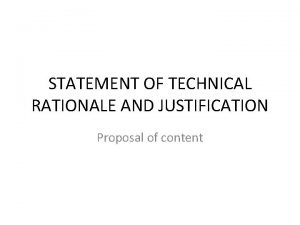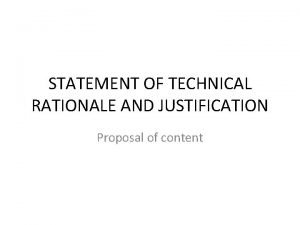STATEMENT OF TECHNICAL RATIONALE AND JUSTIFICATION Proposal of




- Slides: 4

STATEMENT OF TECHNICAL RATIONALE AND JUSTIFICATION Proposal of content

Content: 1. Introduction 2. Procedural background 3. Existing regulations, directives and international voluntary standards 3. 1 Technical references in the original development of this GTR No 2 a. UN Regulation No. 40, 01 series of amendments b. EU Regulations: • Regulation (EU) No 168/2013 amended by Regulation (EU) 2019/129. • Regulation (EU) No 134/2014 amended by Regulations (EU) 2016/1824 and 2018/295 c. Indian Regulation • Mo. SRT&H/ CMVR/ TAP-115/116 and Central Motor Vehicle Rule No. 115 • AIS 137 Part 1 d. Japanese Regulation • Road vehicle Act, Article 41 "Systems and Devices of Motor Vehicles" • Safety Regulations for Road Vehicles, Article 31 "Emission Control Devices“ e. USA Regulations: • US-FTP Subpart F, Emission Regulations for 1978 and Later New Motorcycles f. ISO standards: • ISO 11486 (Motorcycles - Chassis dynamometer setting method); • ISO 6460 (gas sampling and fuel consumption); • ISO 4106 (Motorcycles -- Engine test code -- Net power);

Content: 3. 2 Technical references in developing this revision of the GTR a. Test type I: • • UN GTR 15 (WLTP); UN Regulation 40, UN Regulation 47 and UN R. E. 3; UN Regulation 83; Regulation (EU) No 168/2013; b. Test type II: • UN Regulation 40, UN Regulation 47; UN Regulation 83 • Regulation (EU) No 168/2013 • CITA c. Test type VII: • UN Regulation 101, UN Regulation 83; • Regulation (EU) No 168/2013 3. 3 Methodology for deriving harmonised test procedures for this revision of the GTR • Make reference to the different points that the CP and stakeholders considered to introduce in this technical report. Further developed in EPPR-28 -04 (EPPR Sec. )

Content: 3. 3 Regulatory impact and economic effectiveness a. Anticipated benefits: • It would be more economically efficient to have manufacturers using a similar test procedure worldwide wherever possible to prove satisfactory environmental performance before placing a product on the market. b. Potential cost effectiveness: • No full impact assessment • Advantage to citizens (improvement of environment






